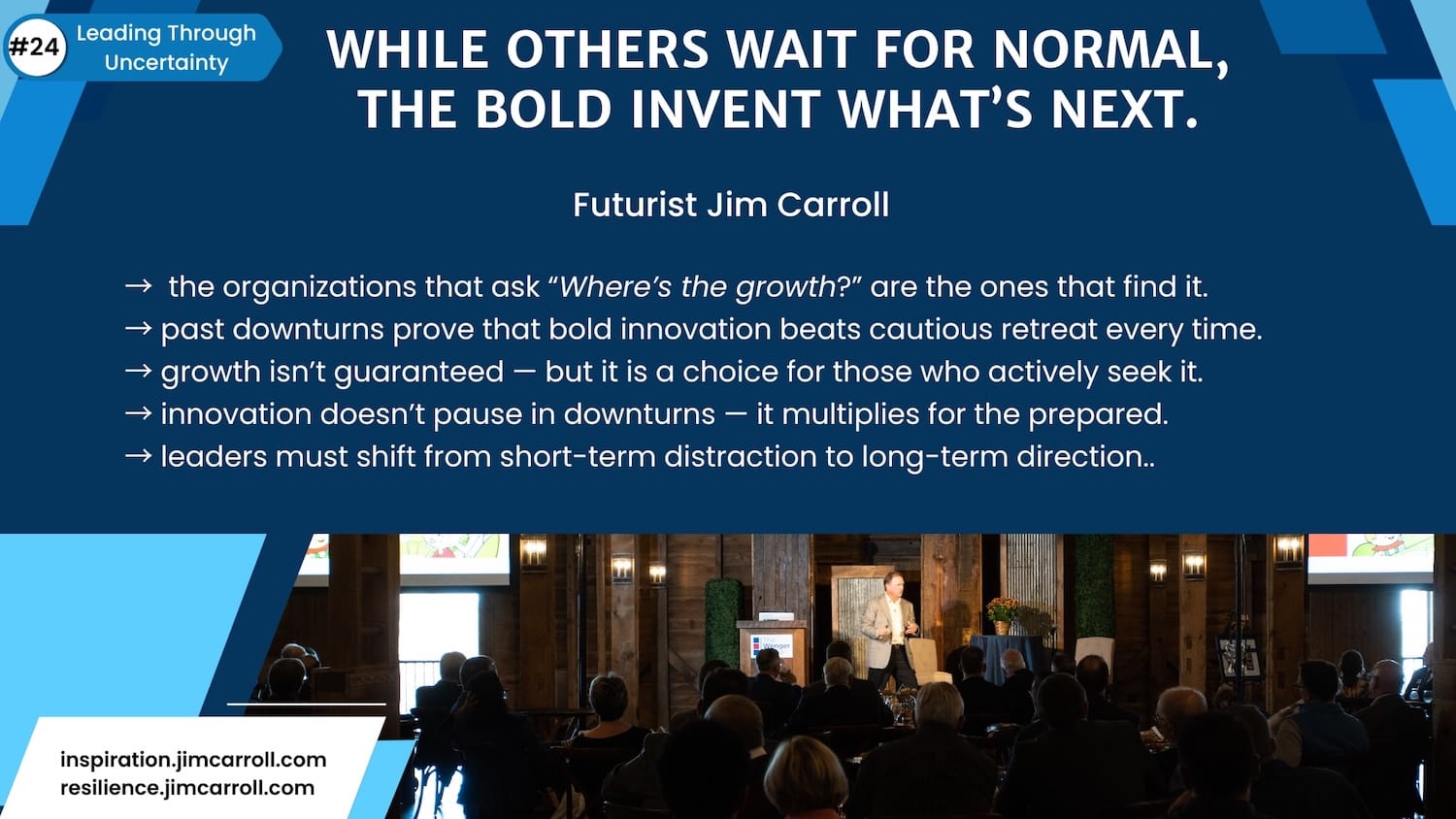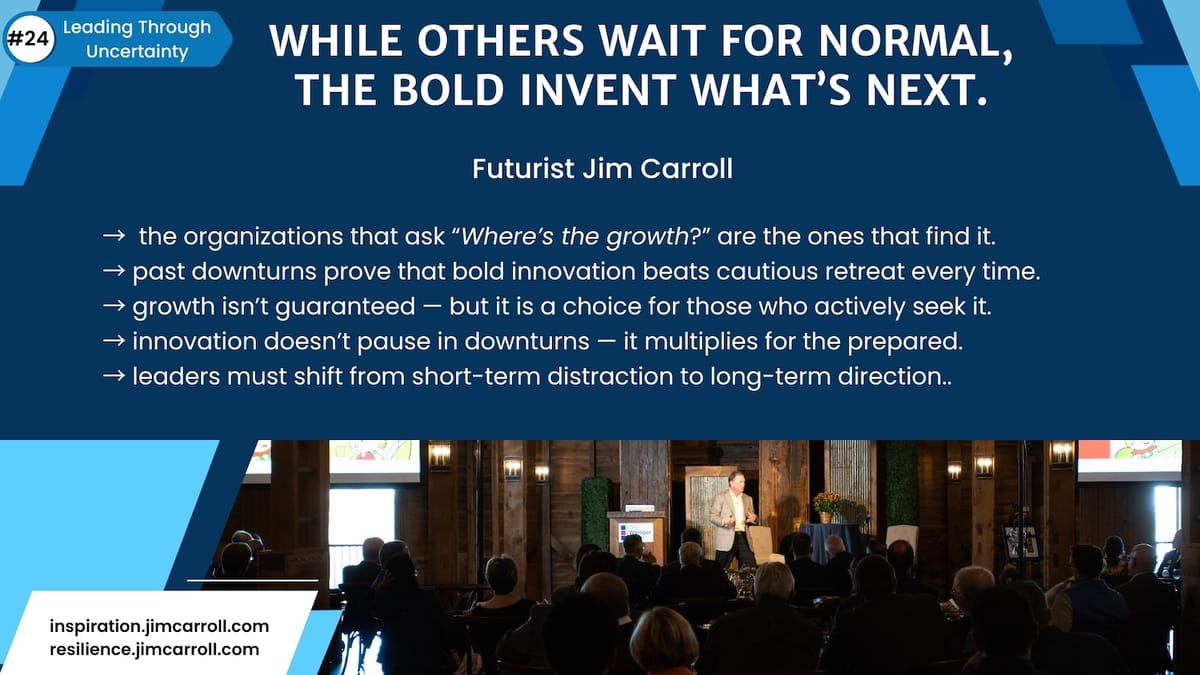"While others wait for normal, the bold invent what’s next." - Futurist Jim Carroll

Know what you don’t know about tomorrow.
Find out what you need to know.
Know it.
Then do it.
That's your resilience playbook right there!
That's how you grow into your future.
If there’s one thing this series - and soon to be a book - has emphasized, it’s this: the future isn’t waiting for you to catch up. It’s already in motion. And in times of volatility, downturn, or disruption, the winners are those who don’t just react to change—they run toward it.
The single most important question you should ask yourself as a leader, strategist, or builder of tomorrow is simple: Where’s the growth? What's the opportunity? Where do you find your future?
And the simple fact is - the future is already here. It surrounds you. You just need to see it and act on it. At every single moment, new opportunities are unfolding around you. The key is training yourself to see them. That means:
- looking to the edges: Trends don’t begin in headlines—they begin in hackerspaces, niche communities, small research labs, and startups. History shows that the future first reveals itself in unexpected places.
- looking where others aren’t: True innovation comes from unconventional thinking. Study niche scientific breakthroughs, obscure tech forums, and emerging markets.
- spotting trends hiding in plain sight: Many of tomorrow’s biggest disruptions are already here, just under-appreciated. No-code tools, energy storage breakthroughs, or micro-manufacturing weren’t obvious when they started.
- projecting yourself forward: Look back from the future. Where would you wish you had acted sooner? Now act.
- finding the collisions: Hyperconnected opportunities happen at the intersection of ideas. AI + agriculture. Blockchain + logistics. Gaming + architecture. Find the overlaps.
- challenging the skeptics: Trends often dismissed as fads are the ones that end up transforming industries in the long run, not the short term. Cloud computing. Green energy. AI. History proves it again and again.
Speaking of spotting trends and embracing what's next, here are 50 major mega-trends that are shaping our future right now. Every single one of these trends provides growth opportunities. They don't disappear because of uncertainty, a downturn, or a recession. That's the funny thing about trends - they're the energizer bunny of tomorrow because they just keep going and going and going.
- Electrification Revolution: The rapid shift from combustion engines to electric vehicles, integrated charging infrastructure, and the decline of traditional automotive players unable to adapt to this technological transformation.
- Energy Decentralization: Evolution from centralized power grids to interconnected two-way energy systems, with integrated home microgrids combining renewable sources, storage, and smart management becoming billion-dollar industries.
- Healthcare Transformation: Movement from reactive treatment to preventive and predictive medicine through constant bio-monitoring, connected pharmaceuticals, DNA-based approaches, and AI-assisted diagnostics.
- Agricultural Reinvention: Emergence of connected farming, vertical farming in megacities, robotic farm management, data-transmitting crops, and 24-hour autonomous farming operations changing our food systems.
- AI-Driven Automation: Expansion of machine learning beyond human-written code to self-learning systems affecting every industry, creating massive productivity shifts and entirely new business models.
- Extended Human Longevity: Dramatic increases in lifespan through medical breakthroughs including lab-grown replacement organs, brain augmentation technology, and bionic implants.
- Next-Generation Manufacturing: Shift from mass production to mass customization, with 3D printing (including biological materials) enabling personalized production at scale.
- Embedded Intelligence: Proliferation of smart, connected objects in everyday life - from clothing to sports equipment to home fixtures - creating omnipresent sensing and feedback networks.
- Transportation Autonomy: Transformation from human-operated vehicles to self-driving, interconnected transport systems that communicate with infrastructure and each other.
- Business Model Acceleration: The increased pace of business model obsolescence as digital disruption compresses innovation cycles, with successful companies of today facing Kodak/Blockbuster-style irrelevance without continuous reinvention.
- Knowledge Explosion: Exponential growth in information volume (particularly in fields like medicine), creating both opportunities and challenges in knowledge management and application.
- Just-in-Time Systems: Evolution of insurance, education, and other services from static models to real-time, data-driven, personalized approaches adapting continuously to changing conditions.
- Human-Technology Integration: Deeper merging of technology with human biology through implants, augmentation, and monitoring, blurring the boundary between person and device.
- Geopolitical Realignment: Major shifts in global economic and political power, with the rise of Africa as an economic force and potential democratic instability in previously stable nations.
- Post-Physical Retail: Fundamental restructuring of consumer commerce beyond traditional shopping models, with physical spaces being reimagined for different functions.
- Resource Optimization: Development of technologies focused on sustainability and efficiency in response to environmental pressures, including renewable energy dominance over fossil fuels.
- Connectivity Ubiquity: Exponential expansion of network capacity (from megabits to yottabits) enabling previously impossible applications and services through always-on, high-bandwidth connections.
- Digital Twinning: Creation of virtual representations of physical entities (from farms to organs) allowing for simulation, optimization, and control at unprecedented levels.
- Career Obsolescence and Creation: Rapid elimination of traditional jobs coupled with the emergence of entirely new professions and career categories not yet imagined.
- Security Imperatives: Elevation of cybersecurity from technical concern to existential business risk requiring board-level attention as digital dependencies deepen across all sectors.
- Personalized Biological Systems: The shift toward individualized health and nutrition based on personal DNA profiles, including custom food plans, personalized medicine, and DNA-specific organ/tissue development.
- Democratized Advanced Technology: High-tech tools becoming accessible to average consumers (like affordable DNA sequencers at dollar stores), enabling innovation from previously excluded populations.
- Intergenerational Expansion: Unprecedented longevity creating new social dynamics with the possibility of many living generations simultaneously coexisting, requiring new models for family relationships and generational wealth transfer.
- Digital Identity Evolution: The transformation of personal representation in digital spaces, from avatars to deep-fake personalities, creating new forms of entertainment, interaction, and identity management.
- Regulatory Disconnection: Growing gap between the speed of technological change and regulatory frameworks' ability to adapt, creating both challenges and arbitrage opportunities in governance models.
- Material Science Revolution: Exponential growth in new chemical substances and materials (from 19 million to 5 billion by 2100) enabling previously impossible products and solutions across industries.
- Cognitive Enhancement: Development of technologies specifically focused on brain health, function and augmentation, similar to how heart health was transformed in the 20th century.
- Meta-Knowledge Systems: New approaches to managing rapidly changing information landscapes, including just-in-time learning and solutions to problems like digital decay (link rot).
- Experiential Transformation: Revolutionary changes in how humans experience reality, from being able to perceive the world as other species do to entirely new sensory interfaces.
- Urban Reimagination: Fundamental restructuring of city functions and spaces as megacities evolve, with new integrated systems for food, energy, transportation, and living spaces.
- Infrastructure Intelligence: Evolution of physical infrastructure (roads, buildings, utilities) from passive to active systems that generate power, collect data, and interact with vehicles and devices.
- Generational Value Shifts: Accelerated change as change-resistant demographics (like baby boomers) exit the workforce and economy, allowing for more rapid adoption of new paradigms.
- Environmental Technology Integration: Development of technologies that simultaneously address climate challenges while creating economic value, like electricity-generating windows and sustainable alternatives to energy-intensive systems.
- Temporal Flexibility: The decoupling of activities from traditional time constraints (like 24-hour farming), creating new operational models and efficiencies across industries.
- Data Physicalization: The embedding of data collection and transmission capabilities into previously analog objects and environments (crops, sporting equipment, clothing), creating entirely new information streams.
- Anticipatory Design: Systems designed to predict needs and respond before traditional triggers occur, from maintenance to healthcare to consumer experiences.
- Micro-Autonomous Systems: Proliferation of tiny specialized robots and drones for specific functions (crop tending, pollination, inspection), creating swarm-based solutions to complex problems.
- Knowledge Obsolescence Management: New approaches to handling the accelerating rate at which established knowledge becomes outdated, affecting education, training, and expertise certification.
- Digital-Physical Convergence: The blurring boundary between virtual and physical worlds through technologies like heads-up displays rather than fully immersive "metaverse" experiences.
- Legacy System Transformation: The reimagining of established structures (like shopping malls) for entirely different purposes as their original functions become obsolete.
- Digital Trust Infrastructure: Development of systems, technologies, and governance models to address growing security vulnerabilities as digital dependencies deepen, moving cybersecurity from a technical afterthought to a foundational requirement.
- Sovereign Technology Ecosystems: Nations and regions developing self-sufficient technology stacks and supply chains in response to geopolitical tensions, creating parallel technology ecosystems.
- Bio-Digital Convergence: The integration of biological processes with digital technologies, creating hybrid systems that leverage the strengths of both domains (like DNA-based computing or bio-reactive materials).
- Ambient Intelligence: Evolution of computing from device-based interfaces to omnipresent, invisible systems embedded throughout environments that respond to presence, voice, and gesture.
- Temporal Commerce: Business models built around time efficiency, anticipatory delivery, and frictionless transactions (like vehicle dashboard payment systems), prioritizing convenience and speed.
- Hyper-Personalization at Scale: Systems capable of mass delivery of individually customized experiences, products, and services based on comprehensive personal data profiles.
- Analog Renaissance: Selective return to physical, tactile, and non-digital experiences as premium alternatives in an increasingly virtual world, creating new value for intentionally non-digital products and services.
- Human Interface Evolution: Transformation of how humans interact with technology, moving beyond screens and keyboards to neural interfaces, gesture control, and ambient voice systems.
- Abundance Management: New approaches to handling post-scarcity dynamics in specific domains (like information, renewable energy, or computational capacity) while addressing continued scarcity in others.
- Cross-Disciplinary Innovation: The most valuable breakthroughs increasingly occurring at the intersection of previously separate fields, creating premium value for integration skills and systems thinking approaches.
These aren't distant sci-fi scenarios - they're happening now, creating massive opportunities for those paying attention. When you look at these mega-trends, you see the blueprint for what's coming next.
We've seen the importance of developing foresight, accelerating decision-making, and embracing the edge of innovation as core competencies of resilient leadership. These habits fuel your ability to see opportunity where others see only chaos. But it's developing the ability to look further despite the uncertainty around you that will define your opportunity.
Is there a future out there? Definitely yes, but a constant drumbeat of negative news can cause people and organizations to lose sight of what will happen. That's why you should focus on accelerating your insight into some of the key trends that will impact industries, organizations, and careers in the next few years,
What underlies all these trends? Despite a downturn or recession, knowledge still accelerates. The global idea machine still reverberates. Big thinkers still think of how to solve big challenges. Inventors still invent. Dreamers still dream. Innovators still innovate. Doers still do. Change agents can still affect positive change.
And most important? Optimism will always overcome pessimism!
No barrier to the future is insurmountable with the right determination! The simple fact is this.
- New Markets Will Always Emerge: Entirely new industries and product categories are being created every year. Think clean tech, longevity science, and immersive media.
- Innovation Will Always Define Market Leaders: Companies that continue to innovate in customer service, product design, and experience win regardless of economic cycles.
- Tech Will Always Accelerate and Never Slow Down: From medical devices to smart cities, every sector is becoming a tech sector.
- Agility Beats Size: Supply chains are being reinvented. Fast beats big. Responsive beats rigid.
- Global Idea Cycles Are Speeding Up: Innovation spreads globally overnight. Garage tinkering becomes an industry transformation in months.
- Generational Shift Means New Mindsets: Younger generations don’t wait. They create. Their digital-native mindset changes everything.
- Information Velocity Compresses Recovery: People bounce back faster now. Acceptance arrives sooner. Innovation moves quickly.
- Transformative Thinking Drives Results: Those who think big and bold during downturns lead the upturns.
You need to look to these ideas, which will allow you to ignore the noise and follow the signals. Here's what I know - every single time that volatility has raged, markets have melted down, and a downturn settled in - innovation was still booming. Real leaders, following trends, doubled down on investment, strategy, and future opportunity.
Growth is not a given - but it is available. And it belongs to those who choose to seek it out, no matter the circumstances. You can’t wait for a perfect moment to act. You need to act in the moment you have.
When others hesitate, you move.
When others cut, you invest.
When others wait for clarity, you create it.
That’s where the growth is.
Are you ready?
Futurist Jim Carroll follows trends. Obviously.

